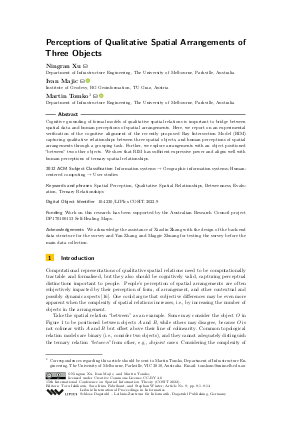Perceptions of Qualitative Spatial Arrangements of Three Objects
Authors
Ningran Xu,
Ivan Majic  ,
Martin Tomko
,
Martin Tomko 
-
Part of:
Volume:
15th International Conference on Spatial Information Theory (COSIT 2022)
Part of: Series: Leibniz International Proceedings in Informatics (LIPIcs)
Part of: Conference: Conference on Spatial Information Theory (COSIT) - License:
 Creative Commons Attribution 4.0 International license
Creative Commons Attribution 4.0 International license
- Publication Date: 2022-08-22
File

PDF
LIPIcs.COSIT.2022.9.pdf
- Filesize: 1.12 MB
- 14 pages
Document Identifiers
Subject Classification
ACM Subject Classification
- Information systems → Geographic information systems
- Human-centered computing → User studies
Keywords
- Spatial Perception
- Qualitative Spatial Relationships
- Betweenness
- Evaluation
- Ternary Relationships
Metrics
- Access Statistics
-
Total Accesses (updated on a weekly basis)
0Document
0Metadata
Abstract
Cognitive grounding of formal models of qualitative spatial relations is important to bridge between spatial data and human perceptions of spatial arrangements. Here, we report on an experimental verification of the cognitive alignment of the recently proposed Ray Intersection Model (RIM) capturing qualitative relationships between three spatial objects, and human perceptions of spatial arrangements through a grouping task. Further, we explore arrangements with an object positioned "between" two other objects. We show that RIM has sufficient expressive power and aligns well with human perceptions of ternary spatial relationships.
Cite As Get BibTex
Ningran Xu, Ivan Majic, and Martin Tomko. Perceptions of Qualitative Spatial Arrangements of Three Objects. In 15th International Conference on Spatial Information Theory (COSIT 2022). Leibniz International Proceedings in Informatics (LIPIcs), Volume 240, pp. 9:1-9:14, Schloss Dagstuhl – Leibniz-Zentrum für Informatik (2022)
https://doi.org/10.4230/LIPIcs.COSIT.2022.9
BibTex
@InProceedings{xu_et_al:LIPIcs.COSIT.2022.9,
author = {Xu, Ningran and Majic, Ivan and Tomko, Martin},
title = {{Perceptions of Qualitative Spatial Arrangements of Three Objects}},
booktitle = {15th International Conference on Spatial Information Theory (COSIT 2022)},
pages = {9:1--9:14},
series = {Leibniz International Proceedings in Informatics (LIPIcs)},
ISBN = {978-3-95977-257-0},
ISSN = {1868-8969},
year = {2022},
volume = {240},
editor = {Ishikawa, Toru and Fabrikant, Sara Irina and Winter, Stephan},
publisher = {Schloss Dagstuhl -- Leibniz-Zentrum f{\"u}r Informatik},
address = {Dagstuhl, Germany},
URL = {https://drops.dagstuhl.de/entities/document/10.4230/LIPIcs.COSIT.2022.9},
URN = {urn:nbn:de:0030-drops-168948},
doi = {10.4230/LIPIcs.COSIT.2022.9},
annote = {Keywords: Spatial Perception, Qualitative Spatial Relationships, Betweenness, Evaluation, Ternary Relationships}
}
Author Details
- Department of Infrastructure Engineering, The University of Melbourne, Parkville, Australia
Funding
Work on this research has been supported by the Australian Research Council project DP170100153 Self-Healing Maps.
Acknowledgements
We acknowledge the assistance of Xiaolin Zhang with the design of the back-end data structure for the survey and Yan Zhang and Maggie Zhuang for testing the survey before the main data collection.
References
-
Raechel A Bianchetti, Jan Oliver Wallgrün, Jinlong Yang, Justine Blanford, Anthony C Robinson, and Alexander Klippel. Free classification of canadian and american emergency management map symbol standards. The Cartographic Journal, 49(4):350-360, 2012.

-
Isabelle Bloch, Olivier Colliot, and Roberto M Cesar. On the ternary spatial relation" between". IEEE Transactions on Systems, Man, and Cybernetics, Part B (Cybernetics), 36(2):312-327, 2006.

-
Eliseo Clementini and Roland Billen. Modeling and computing ternary projective relations between regions. IEEE Transactions on Knowledge and Data Engineering, 18(6):799-814, 2006.

-
Anthony G Cohn, Brandon Bennett, John Gooday, and Nicholas Mark Gotts. Qualitative spatial representation and reasoning with the region connection calculus. GeoInformatica, 1(3):275-316, 1997.

-
Max J Egenhofer and Robert D Franzosa. Point-set topological spatial relations. International Journal of Geographical Information System, 5(2):161-174, 1991.

-
Laura Ferreira and David B Hitchcock. A comparison of hierarchical methods for clustering functional data. Communications in Statistics-Simulation and Computation, 38(9):1925-1949, 2009.

-
Sally Fincher and Josh Tenenberg. Making sense of card sorting data. Expert Systems, 22(3):89-93, 2005.

-
Alexander Klippel. Topologically characterized movement patterns: A cognitive assessment. Spatial Cognition & Computation, 9(4):233-261, 2009.

-
Alexander Klippel and Rui Li. The endpoint hypothesis: A topological-cognitive assessment of geographic scale movement patterns. In International Conference on Spatial Information Theory, pages 177-194. Springer, 2009.

-
Alexander Klippel and Daniel R Montello. Linguistic and nonlinguistic turn direction concepts. In International Conference on Spatial Information Theory, pages 354-372. Springer, 2007.

-
Alexander Klippel, Michael Worboys, and Matt Duckham. Identifying factors of geographic event conceptualisation. International Journal of Geographical Information Science, 22(2):183-204, 2008.

- Ivan Majic, Elham Naghizade, Stephan Winter, and Martin Tomko. Rim: a ray intersection model for the analysis of the between relationship of spatial objects in a 2D plane. International Journal of Geographical Information Science, 35:893-918, May 2021. URL: https://doi.org/10.1080/13658816.2020.1778002.
- Ivan Majic, Elham Naghizade, Stephan Winter, and Martin Tomko. There is no way! Ternary qualitative spatial reasoning for error detection in map data. Transactions in GIS, 25(4):2048-2073, 2021. URL: https://doi.org/10.1111/tgis.12765.
-
Paul Martin, Paul Patrick Gordon Bateson, and Patrick Bateson. Measuring behaviour: an introductory guide. Cambridge University Press, 1993.

-
Glenn W Milligan and Martha C Cooper. Methodology review: Clustering methods. Applied psychological measurement, 11(4):329-354, 1987.

-
David R Olson and Ellen Bialystok. Spatial cognition: The structure and development of mental representations of spatial relations. Psychology Press, 2014.

- D A Randell, Z Cui, and A Cohn. A spatial logic based on regions and connection. In B Nebel, C Rich, and W Swartout, editors, KR'92. Principles of Knowledge Representation and Reasoning: Proceedings of the Third International Conference, pages 165-176, San Mateo, California, 1992. Morgan Kaufmann. URL: http://citeseer.ist.psu.edu/randell92spatial.html.
-
Jed R Wood and Larry E Wood. Card sorting: current practices and beyond. Journal of Usability Studies, 4(1):1-6, 2008.

